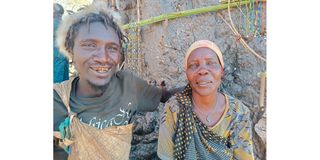Hadzabe, the Tanzanian tribe where women call the shots

Katarina Hassan with her husband Apalii Saitoti Thufu at the foot of a baobab tree at Sonai settlement within the Yaeda valley in Karatu district, Arusha region, on June 2, 2023.
What you need to know:
- In this hunter-gatherer community, women build and own homes, and can kick out their husbands; in case of divorce, a man leaves with what he came with and goes back to his parents.
- Surprisingly, despite their rudimentary lifestyle, they do better than many modern societies on girl rights protection; they don't tolerate child marriages and female genital mutilation.
Tap! Tap! Tap! A brown antelope calf hops across a smooth graded Karatu-Mang'ola road in Oldeani, a cool area in northern Tanzania covered in maize, sunflower, beans and coffee plantations.
Past Oldeani, it gets hot and windy. It's dusty too. As we get closer, we notice bushes, shrubs and indigenous trees scattered all over. We are headed to meet the Hadzabe in the depths of forests of Yaeda Valley near Lake Eyasi in the Arusha region.
This hunter-gatherer community has also settled in Serengeti Plateau, on the side of Meatu District in the Simiyu region. The plateau borders Kenya. Others are spread across the forests of Mbulu and Kiteto districts in the Manyara region.

A section of Sonai settlement on June 2, 2023.
The Hadzabe are among about 130 ethnic groups in Tanzania. They are known by different variations—Hadzabi, Hadzane, Hadzape, Hadzapi, Hatsa and Watindiga. In the Kilimanjaro region, for instance, they are known as Watindiga. In Mtwara, they call them Wazabi.
Though Tanzania’s 2022 Census has not provided their population estimates, the United Nations says their numbers range from 1,300 to 1,500, a handful of the 61.7 million Tanzanians.
Endeko Endeko, a member of this community, is helping us locate his people who have settled in the Melekaa area.
There are no roads or signage here to give a sense of direction.
Slight change
Some progress though, the Hadzabe now own mobile phones, which they buy with the money visitors donate to them, or from their beadwork proceeds. The phone signal is, however, poor here.

A display of ornaments the Hadzabe sell to visitors at Sonai settlement, on June 2, 2023.
We access Melekaa from Mang’ola trading centre, a remote business area with only one hotel and a few shops. After diverting onto a bumpy road described as “hiyo barabara ya kwenda kwa wa Hadzabe (that road leading to the Hadzabe),” we manoeuvre through the rocks and shrubs.
We finally arrive at the foot of a huge baobab tree with a cave on its trunk. Before it, is a dusty open field surrounded by more baobabs and shrubs. On the right is a hillock of intimidating boulders resting on each other, forming a somewhat fortification for the community.
Shortly, a man in shorts and a brown sleeveless shirt walks down. Over his shoulder is a beaded skin. His foot is covered with grey tyre sandals and a knife is strapped to his shorts. He holds an arrow. This is Mambosi Jioja, the chairperson of the Sonai Hadzabe group.
The Hadzabe are communal, have a nomadic lifestyle and depend on game meat and wild fruits. For the last 30 years, however, they have never moved from here, Mambosi says. They live behind the hillock. Mambosi leads us up.

Mambosi Jioja inside a cave under a baobab tree trunk on June 2, 2023. He is the chairperson of the Hadzabe group.
As we crawl up, my heart freezes. A slide backward means an early visit to my ancestors. Furthermore, background research informed me that tiger and bark snakes are common here. I wonder if some are lurking under the rocks.
Mambosi is agile. I can't keep up with him. For a few seconds, I stand to catch a breath amid a whiff of nutty-burnt tyre air.
I ask him if a snake has stung anyone in the recent past. His response in the negative is consoling. He says they only bite if provoked. The Hadzabe don't eat snakes as many presume, Mambosi says.
We finally arrive in Sonai, where about 180 Hadzabe have settled in 35 brandy dome huts.
On a log under a towering baobab tree are men crafting sticks with knives to make arrows. A few yards behind them are women sitting on the ground watching over their merchandise lined up on makeshift display structures under the baobab tree.
Necklaces, bangles, earrings, headbands and ornamental gourds hang from the branches and hangers made from cactus, fixed on the tree. I later discover that this baobab tree, in the middle of the settlement, is a landmark serving as a special meeting point for the community.
I greet the men: “Hamjambo? (How are you?).”
I receive a rude response; they just smile and continue sharpening their arrows.
Although this community mainly speaks their native language Hadzabe, their Swahili is fluent. So they heard me. But apparently, I have broken their greeting code.
Mambosi shows me what I am expected to do. Their greeting is special. I shake their hand and say 'mtana' for hello. But the mtana is escorted with some kind of Maasai dance in the form of a rhythmic combination of sounds of kissing, clicking and mumbling like mwaah, knah, mmm, mtana!
Having mastered the art, it becomes easier to greet the women. I request to speak with the women and Katarina Hassan quickly takes the wings.
She welcomes me to her low-height hut built from branches and leaves of indigenous trees. It’s also covered with cream tarpaulin, white sack and canvas, materials left behind by visitors. It has no window—only a door of a coloured shawl.
We sit down on a hide of a buffalo, covered with a coloured leso.
“What are the roles of a man and woman in your community?” I ask her.
“His work is to hunt and bring home honey for the family,” she explains. “A woman is to dig up roots and tubers and collect wild fruits.”
The environment has open patches, a clear sign of lost flora to accommodate fauna, their source of livelihood. The changing times has, however, not shifted the community’s expectations as is the case for modern society where women assume roles previously restricted to men.
“Our roles still stand. I can’t go hunting. Neither can he go collecting fruits or tubers; that is my work. That is how it is. That’s a culture passed down to us,” she reckons.

Katarina Hassan digs out a tuber on June 2, 2023.
They have, however, defied the kind of food they eat. She says the harsh weather conditions and conversion of parts of the forest to farms have disturbed the area's ecology, resulting in dwindled production and presence of their wild food.
The wild animals they hunted—antelopes, wildebeests, baboons, dik-dik, buffaloes and zebras—have gone missing.
Special status
According to the UN, the Hadzabe are one of the last remaining hunter-gatherer communities on Earth. In Tanzania, it is the only community allowed to source its food through hunting and gathering, says Zakaria Faustin, executive director of Tanzania Natural Resources Forum.
He says Tanzania’s first President Mwalimu Nyerere issued a decree recognising and protecting the community’s special status. The order stands, he says.
But the changing ecosystem threatens their special status. “Whenever they (animals) want to come here, they hear meee, mooo, owh, ting, ting and they run away,” Maliseli Sadiki, a young man who says he is 22, illustrates their frustration with the disappearance of the wild animals.
“These days, you walk for long until you get tired and hunger pangs and thirst overwhelm you. So, you’re forced to excavate tubers to eat. They are succulent and quench your thirst,” says Maliseli, whose dressing is like a billboard of the animals they hunt.

Katarina Hassan holds a tuber on June 2, 2023.
Hanging over his faded black T-shirt and blue knee denim short, are skins and hides of antelope, wildebeest, baboons, dik-dik, buffalo and zebra.
The community has embraced other food. “We eat rice and ugali with vegetables,” says Katarina.
“Usually, visitors bring us maize flour, rice, indigenous vegetables, tomatoes and cooking oil. If anyone gifts us with money, we use it to buy food and distribute it among ourselves.”
Togetherness
Here, nearly everything is done communally. It is the community chairperson who receives any gift on their behalf, including money and food, then he shares it out.
If it’s food, it has to be adequate enough to feed all of them. If it’s water, sourced from a borehole miles away, the money ought to be enough to buy at least one jerrycan of 20 litres for each household at Tsh1,000 (Ksh57.58).
True to Katarina’s submission, during my short time with the community, some foreign tourists gift them with maize flour, assorted indigenous vegetables, tomatoes and some money to buy cooking oil. Mambosi leads the distribution from the baobab tree, the special meeting point.
The women stretch their hands to receive the food. But there is something unique about this whole exercise.
I have witnessed food distribution exercises in Kenya’s Turkana, Baringo and Narok counties and I have never seen a man run to the house to bring a sack to the wife to collect the food. Maybe, I have not been that keen.
Gender power balance is so obvious here. In a generation where UN Women keeps calling for redistribution of household responsibilities, how this community does it is intriguing.
I ask Katarina about the power relations between men and women in their community. “Sisi ni wakali sana kwa wanaume. Sisi ndio tuna uamuzi. Uamuzi ndio wa kwetu. Tukiamua hii, sisi wanawake tumeamua, tusipoamua basi tunaacha (We are more powerful than men. We are the decision-makers and when we decide, our decision is final),” she says.
The power is rooted in marriage culture. Unlike in most cultures across the world where a woman moves into the man’s home once they marry, here, it is the opposite.
“Well, a man woos the woman but she only marries him if he accepts her terms and conditions,” explains Katarina.
“Once he accepts, she builds her house with the support of her mother and other women. The man then joins her. It is her house. Not the man’s,” she says.
The women also determine how much should be paid as reverse dowry. Years ago, they had to bring not less than three baboons, rolls of tobacco and honey, Katarina says.

A section of Sonai settlement.
But these days, due to scarcity of the wild animals, they are allowed to pay in many necklaces, as preferred by the women, and honey.
“The young man will make efforts to find honey, tobacco and necklaces,” explains Mambosi, the Sonai settlement’s chairperson. “The bride’s mother and sister to the groom will only welcome them into the house after the man has fulfilled all the dowry requirements.”
While the women help the bride to construct the house for the incoming husband, the men prepare the groom for his household responsibilities by giving him a honey bag, a skin or hide, knife and arrows, Mambosi says.
So in the case of divorce, the man only leaves with what he came with. That is his only possession. “The children belong to the women. They may have his surname, but it is the women who call the shots,” insists Katarina.
Apalii Saitoti Thufu, Katarina’s husband, proudly acknowledges the power of women here. “If she tells you to leave, you’ll leave. If she allows you to leave with the children then fine,” he says.
In jest, I interject: “But you can refuse to leave.”
He quickly counters: “How can you refuse to go, yet the house is hers. Even if you were to go with the children, where would you host them when you don’t have a house?”
“Is there a problem building a house for yourself and the children?” I ask.
He responds: “No, no! It’s not in our tradition for a man to build a house. That’s the work of women. If she chases you away, you return to your parents. And you’ll just sleep in the open or create some sort of a structure to sleep under.”
Apalii says he was born in Ghorofani, another settlement in Karatu District and moved to Sonai where his wife built a house. Together, they have two children.
I ask Katarina the main reason why women chase away the men and she says: “Kama nimechoka kuchimba mizizi si nitakuwa mkali? (How can I not be rattled if I am bogged down with excavating roots?)”
Maliseli is a victim. He was born here but had a wife in Endamaka, another settlement in Karatu district. They had two children.
But he says he recently returned to his parents, after disagreeing with his wife. She remained with the children. He says he hasn’t seen the children since he left, but given the chance, he can visit them.
He struggled to respond to the query of where he lives. “Mimi naishi kama mimi, kama mimi, kama mimi (As for me, I, I, I live).”
Unlike in many parts of Tanzania and Kenya, where female genital mutilation and child marriages are prevalent, among the Hadzabe, such harmful practices are zero. They are detested. However, girls go through a rite of passage.

A Hadzabe. Girls wear headbands once they begin menstruating.
“If a girl taints her clothes, we will know she has started her menses,” explains Mindi Saitoti, “or if she doesn’t know what’s happening, she will ask her mother."
"The same day she makes the report, the women contribute beaded necklaces and a headband to decorate her. That shows she is mature.
"But it doesn’t mean she is ready for marriage. If a man intends to marry her, her mother must approve of it and they never do so unless she is above 18 years,” she says.
Mindi is married and has three children. She and her husband, Tabashi Chalesi, were born here. She built a house a few yards away from her parents’ and they live happily.
I am curious to find out if Tabashi finds it strange to live near his in-laws. But it sounds like a weird question.
“Strange, how?” he asks.
“We are okay. What is the problem with that?”
I rest my case. Meanwhile, the men have their own way of telling when a woman is ready for marriage.
“You look at the chest. If the breasts are sagging and she has a necklace, you will know she is suitable for marriage,” says Mambosi.
Education
Although the Tanzanian government has made efforts to take its children to school, the Hadzabe who get an education still return to the forest to continue with their cultural lifestyle.
The case of Endeko. He got his secondary education in 2015 and later a diploma in governance and development through a scholarship.
But currently, he lives in his home in Yaeda Chini in Mbulu District in the Manyara region. He says forest life is less stressful.
Zakaria of Tanzania Natural Resources Forum describes the process of modernising the Hadzabe as complicated.
“You help them get higher education but they still prefer to go back to the forests,” he notes.
His organisation has previously attempted to help them embrace sustainable means of livelihood but it ended in futility.
“In 2007, we supported them with goats so that they can shift from hunting to keeping goats. But during the dry season, they returned home, shot the goats and ate them,” he says.





